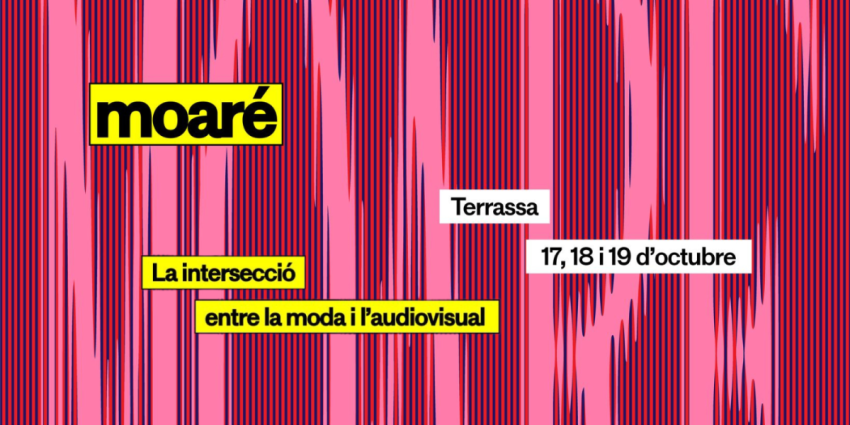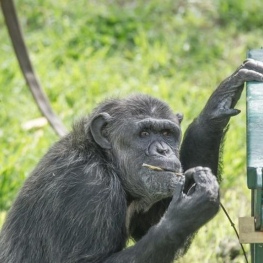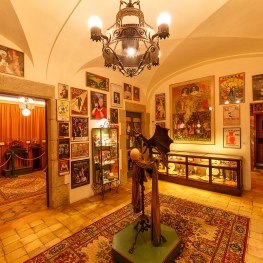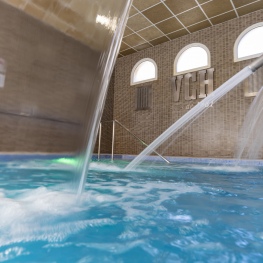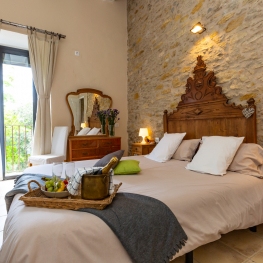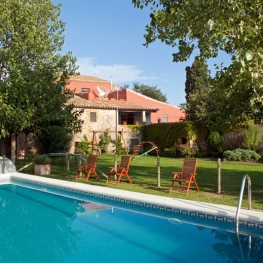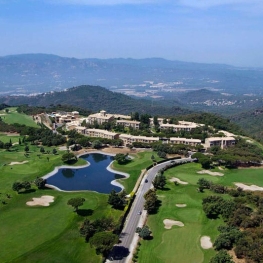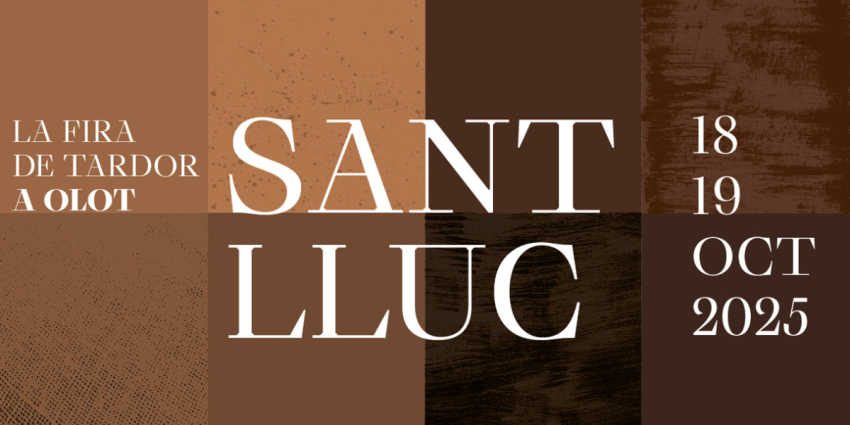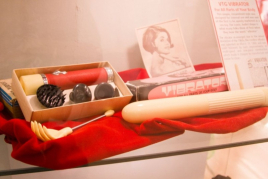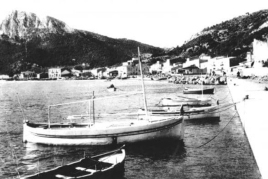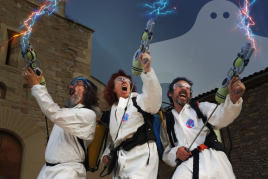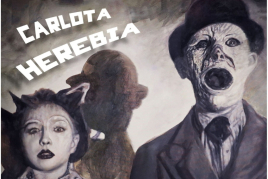Cassà de la Selva route under the bombs
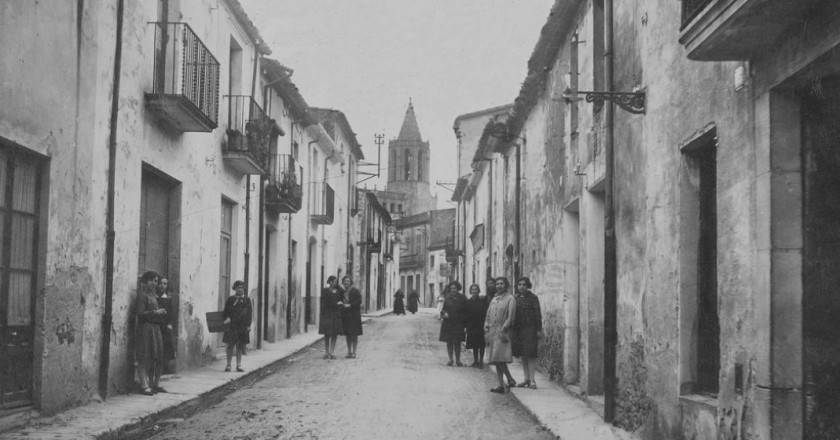
On Sunday, January 29, 1939, at 1:30 p.m., five Savoia Marchetti SM-79 bombers from Italian fascist aviation and led by Captain Costa Egidio were bombing the town of Cassà de la Selva.
From an altitude of 4,000 meters and, taking as a single reference the straight line that drew the Provincial road - the main artery or communication route of the town -, they made a single pass over the town in an east-west direction, releasing its deadly load. In total, about 50 100 kilos bombs fell, killing 8 people and destroying a minimum of 54 houses.
The reasons why Cassà became a military target are yet to be determined. It could be due to the proximity of the Republican airfield of Torremansa (1938-1939) about two kilometers south of the town, due to the existence of the command headquarters of this airfield in Can Trinxeria (modernist house located in the square de la Coma), for the presence of republican troops and international brigades within our population during their withdrawal into exile, for the geostrategic position of our people towards the Girona or Bisbal road before the advance of Franco's troops..
Be that as it may, the anti-aircraft alarms were not sounded and this meant that the civilian population could not be protected or protected. Nor was there any type of air defense. Hence the rebels were bombing and machine-gunning the town with total impunity.
With the creation of this itinerary , Cassà City Council has wanted to recover a part of our most recent history. We invite you to start this route and follow what are the spaces that suffered the effects of this bombing, know what damage they suffered and pay a tribute to all the people who lost their lives.
Bomba (Small Square)
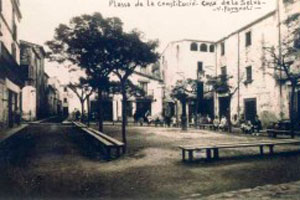 We are in the Small Square. This is the old nerve center of the town of Cassà during medieval times. For centuries it had a great commercial and recreational activity. The entire square was surrounded by shops and the weekly market was held in its central space. In this place the old hospital for the poor was also located (16th century) and it was the place where the jurors of the University of Cassà (precedent of the local government) were chosen through couplets, a curious selection process that is perfectly described in a royal privilege of the 16th century and that was read before the ceremony began in a loud voice in the middle of the public square of the city.
We are in the Small Square. This is the old nerve center of the town of Cassà during medieval times. For centuries it had a great commercial and recreational activity. The entire square was surrounded by shops and the weekly market was held in its central space. In this place the old hospital for the poor was also located (16th century) and it was the place where the jurors of the University of Cassà (precedent of the local government) were chosen through couplets, a curious selection process that is perfectly described in a royal privilege of the 16th century and that was read before the ceremony began in a loud voice in the middle of the public square of the city.
During the bombing of January 29, 1939, a bomb fell on the Avellaneda (current house with number 10) and caused it to collapse. The grandmother of this house was buried under the ruins. Thanks to the rapid action of the neighbors and the local authorities they were able to take it out and rescue it alive.
The shock wave of this bomb also affected the house next to it, known as Can Cunillera (No. 1-2). Its entire facade collapsed, both the one that overlooks Measures street and the one that overlooks Ocata street.
Jacinto Verdaguer Square
After passing through the side of the 18th-century arcaded building where Cassà's old public measures had been located and which had been granted by a royal privilege of medieval times, we have reached the Jacinto Verdaguer Square.
Formerly in this square the Vegetables market was held. For this reason it is not surprising that it was known as Hortalans Square.
During the Civil War a bomb fell in the middle of this square. One of the most affected houses was the current Can Quirze (No. 6-8), a house that for many years was one of the most popular and popular bars-restaurants in the town. Due to this explosion, a large part of its façade fell and damage was also produced both to the roof and its internal structure (partitions, glass, paint, wooden elements).
The houses around the square were also affected by the shock wave of this bomb. Specifically, there were damages in houses number 9, 10, 12 and 14 and also house number 2 on Girona street. All of them suffered minor damage.
It is also worth commenting that due to this explosion a series of shrapnel holes or impacts are still visible on the facade or main wall of the garage that is located just in front of Can Quirze.
Now, we have to continue our journey towards Calle del Molino, passing in front of Can Serra, a beautiful modernist house from the beginning of the 20th century, owned by one of the most important cork oaks of the town.
Mill Street
Molino Street was one of the areas most affected by this bombing. We believe that a minimum of 4 bombs fell along its route. A first bomb fell on the house before us (No. 48). In 1939 at this point 4 houses were built. Three of them were ground floor and floor homes and the other was a warehouse. The explosion of this bomb caused the total destruction of all these buildings and damages of lesser consideration to the other houses that were around (current no. 44, 52 and 54).
Agricultural Union of Cassà
The building in front of us (No. 56) was the headquarters of the old mill or Agricultural Union of Cassà. This large building, currently in disuse and that gives its name to the street where we are located, was the place where the farmers of the town used to grind the cereals they had grown to make flour.
During this bombardment a bomb fell on this building, affecting mainly the house where the miller and his family lived. The floor and ceiling of this house were totally destroyed as well as its internal structure.
Due to this explosion there was also a fatality. This is the youngest daughter of this family, the Concepción Riera Valentín, a 14-year-old girl who died when she left home scared.
It is also worth commenting that according to an oral testimony, that he was a child when these events occurred, after the Civil War two bombs were found that had not exploded at this point.
Down street
Another bomb fell on the first houses on Down Street. Specifically it affected no. 48, 50 and 52 and caused damage of various considerations (covers, partitions, glass...). The shock wave of this bomb also affected the houses around it, such as the house on the corner of Calle del Molino (No. 59).
Mill Street / Provincial Road
At this point where we are now located, no bomb fell directly but it fell into an area full of orchards that were in the space between the houses that overlook Molino Street and those that do so towards the Provincial Highway. Although this bomb did not destroy any building, its shock wave did wreak havoc on the houses around it (No. 138, 140, 149 of the Provincial Highway and 80 and 82 of Molino Street).
According to the testimony of some residents of this area, years ago you could still see the holes or shrapnel impacts caused by this bomb on the facades of the houses on the Provincial road (for example, house no. 140). Due to various works and subsequent remodeling, these holes are currently no longer visible.
Mill Street
In 1939 on this site, currently empty, there was a house that was severely affected by the effects of a bomb that fell on it. Due to this bombing this house collapsed and was never rebuilt again.
Provincial Highway
The Provincial Highway was the area most affected by this bombing. A minimum of 6 bombs dropped along the way.
One of these bombs fell in the middle of the road at the point where we are currently. Its explosion fully affected house no. 102, where the entire main facade sank. It is worth commenting that after the war this house did not take advantage of the compensation given by the Franco authorities to rebuild the houses. This house was damaged and uninhabited for many years, until it was bought and rebuilt by the current owners in the mid-60s.
The explosion also affected the surrounding houses (No. 100, 104, 106 and 111). In fact, if you look closely at the balcony railing of the house that has no. 100 you can still see how it is broken due to the effects of shrapnel.
A few meters below, this same bomb caused the death of a couple living in the current house, which corresponds to no. 110. These were Josep Sureda Casanovas, 47, and Victoria Cassà Teachers, 47, who had no children.
According to oral testimonies, this bomb caused several injuries to a Republican soldier who was walking along the left sidewalk of this street towards Girona at the time of the explosion.
Barceloneta Street
In 1939 Barceloneta Street was located just outside the town. From here there were practically only crop fields, and beyond wooded areas that covered the first hills or buttresses of the Gavarres massif.
During this bombardment a bomb fell on the first houses of this street. According to the documentation consulted, the most affected houses were no. 2, 4, 6 and 8. It was a set of 4 houses formed by ground floor and floor. Two of these buildings were totally destroyed and two more were badly damaged or affected. One of these buildings could not be rebuilt and had to be demolished shortly after the end of the Civil War. The shock wave of this bomb also affected houses no. 10 and 12 of this same street, but caused less significant damage.
Chalet in Vaca (Cuenca street)
Formerly in this currently empty plot (No. 6), he had built a small villa popularly known as Chalet de en Vaca. During this bombardment a bomb fell into this space, and caused material damage worth 3,000 ptas. according to the file of the "Relationship of the value of the damaged or destroyed farms by range of war projectors" which can be consulted in the Municipal Archive of Cassà.
Green area dispensary: Pyrenees street and Bassegoda street
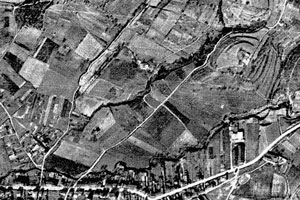 In 1939 this area was full of fields, located on both sides of a stream that descended from the area of Can Prats towards the Seca stream or the Riera del Castillo. Laugh that is currently channeled and buried.
In 1939 this area was full of fields, located on both sides of a stream that descended from the area of Can Prats towards the Seca stream or the Riera del Castillo. Laugh that is currently channeled and buried.
As this area was not urbanized at that time material damage was very scarce. Only the farmhouse of Can Prats, located about 80 meters northeast was slightly affected by the shock wave of this bomb.
Provincial Street
Studied the documentation consulted both in the Cassà archive, Relationship of the value of the damaged or destroyed farms by range of war projectors, as in the Historical Archive of Girona, Records of Devastated Regions, we have been able to verify how a house that was built in this Point and which was formed by ground floor, floor and attic, was slightly affected by the explosion of a bomb. Luckily the damages that this house suffered were of little consideration (cover, partitions, paint, glass...). We could not find more information about it and we do not know the exact place where this bomb fell or other damage it caused in the houses around it.
Now we are facing house no. 71 of the Provincial Highway, where Primitivo Cassà and Maestros lived , CNT councilor at the City Council of Cassà during the Civil War and that after the war he had to go into exile in France. This house. Together with the two previous houses that correspond to no. 69 and 67 were greatly affected by a bomb that fell in the middle of the road.
As a result of this explosion two people died living in house no. 67. It was a mother and daughter named Rosa Torras Gispert, 58, and Dolores Salvador Torras, 27.
The shock wave of this bomb also affected the houses on the other side of the Provincial Highway. Specifically, houses no. 64 and no. 62. Another bomb fell at this point and affected houses no. 46, 48 and 52. These were simple constructions with a similar typology: ground floor, floor and attic.
The shock wave of this bomb also compromised the houses on the other side of the road and caused the death of one person: Lluïsa Xiberta Carbon, 58, who lived in the current no. 61 and who died when unfortunately he opened the door of his house during this bombing.
The largest pumps are 250 kg and the smallest 100 kg are like the ones that fell on Cassà.
Another bomb fell on no. 42, where formerly there were two houses. The house that was located more to the right (direction Llagostera) and that was formed by ground floor, floor and several annexed bodies in the back, was totally destroyed. A woman also died in it: Caterina Payret Suñer, 57.
The houses around it were also quite affected as no. 44 and 40) In the current garage Gruart at number 38, at that time there were two buildings. What was located more to the east is where a woman died: Maria Canals Rojo, 52.
In the housing on the west side according to the documentation located in the Historical Archive of Girona there was damage to the roof, the medieval wall and the windows were broken for a total value of 2,935 ptas. The shock wave of this bomb also reached the other side of the road and affected Can Geronès' house (current number 47).
Finally, it is also worth commenting that the interesting property that makes a corner between the Provincial road and Martí Dausà street (current Can Rich factory) was for many years (from 1912 to 1934) the headquarters of the Cassanense Polytechnic College, popularly known as the Vilaret School. Due to its proximity to the houses we have just described this property was also affected by the effects of this bombing.
Can Trinxeria
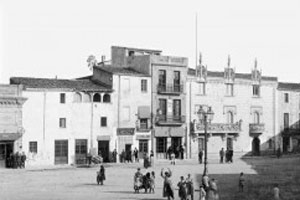 Although at this point a bomb did not fall directly, the house of Can Trinxeria and quite possibly the other houses located around the Plaza de la Coma were affected by the bombs that fell along the Provincial road.
Although at this point a bomb did not fall directly, the house of Can Trinxeria and quite possibly the other houses located around the Plaza de la Coma were affected by the bombs that fell along the Provincial road.
It is worth remembering that this house was confiscated by the republican authorities during the Civil War and that the headquarters of the Republican airfield of Torremansa, which operated between 1938 and 1939, was installed inside.
Source: Cassà de la Selva City Council
You may also be interested in: The Civil War, exile and repression in Catalonia
What to do
Fundació Mona
Riudellots de la Selva (a 5.1 Km)The Mona Foundation is a non-profit entity created to put an end…
El Gran Museu de la Màgia
Santa Cristina d'Aro (a 13.1 Km)Come and discover the Casa Mágica, where automatons, posters, magic devices from…
1881 Hotel Balneari Vichy Catalan
Caldes de Malavella (a 8.2 Km)The bicarbonated and sodium thermal waters of the Vichy Catalán Spring emerge…
Where to eat
L'Espai Gastronomia
Tossa de Mar (a 19.5 Km)Enjoy a place where laughter, festivity, and gastronomy unfold around a large…
Where to sleep
Apartaments Rurals Mas Tarrès
Madremanya (a 13.8 Km)Discover Mas Tarrès, your adults-only rural retreat in Madremanya!
1881 Hotel Balneari Vichy Catalan
Caldes de Malavella (a 8.2 Km)The bicarbonated and sodium thermal waters of the Vichy Catalán Spring emerge…
Casa Rural Mas Masaller
Cruïlles, Monells i Sant Sadurní de l'Heura (a 13.4 Km)Isolated farmhouse almost 3 kilometres from La Bisbal de Empordà. The farmhouse…
Hapimag Mas Nou
Castell - Platja d'Aro (a 13.5 Km)Apartments within the Golf d'Aro complex on the Costa Brava; located in…

